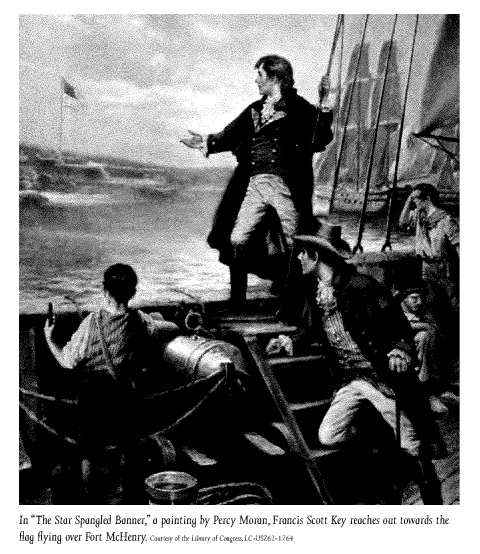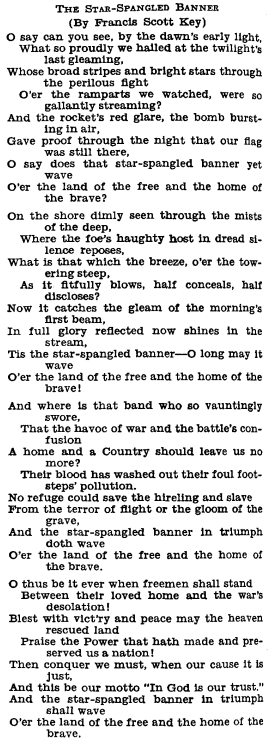Last Friday, March 3, was National Anthem Day in the United States. Why is that, you may ask? Well, March 3, 1931 was the day that “The Star-Spangled Banner” by Francis Scott Key was officially designated the national anthem. However, the lyrics to the song had been penned more than 100 years earlier, during the War of 1812. Join us as we use HeinOnline to explore the meaning behind the anthem and how it came to be the one song that basically every American can recite in their sleep.
Through the Perilous Fight
Francis Scott Key was born on August 1, 1779 at his family’s estate in Maryland. As an attorney,[1]Eugene L. Didier, Francis Scott Key as a Lawyer, 16 GREEN BAG 293 (1904). This article can be found in HeinOnline’s Law Journal Library. he was serving in the Georgetown Light Field Artillery during the War of 1812 between the still young United States and its former mother, Britain. August of 1814 found British troops invading Washington, D.C.—which had been established as the capital of the growing nation in 1790—and burning down the White House, the Capitol Building, and the Library of Congress. After destroying the city, the British then moved on to Baltimore. Meanwhile, Key was called upon to help secure the release of his friend Dr. William Beane,[2]“Washington, the National Capital, by H. P. Caemmerer.” U.S. Congressional Serial Set, , 1930, pp. III-736. HeinOnline, https://heinonline.org/HOL/P?h=hein.usccsset/usconset34670&i=296. This document can be found in … Continue reading who was a prisoner on the British naval ship the Tonnant.

Key and Colonel John Skinner headed off to Baltimore to rescue Beane, but while they were there, the British attack on the city commenced, and so Key, Skinner, and Beane all had to wait at sea until they could safely return to Georgetown.
Bombs Bursting in Air
The British eventually moved on from Baltimore to Fort McHenry,[3]Ronald Reagan, Remarks at a Flag Day Ceremony in Baltimore, Maryland – June 14, 1985, 1985 Pub. Paper 769 (1985). This document can be found in HeinOnline’s U.S. Presidential Library. which they brutally attacked for 25 hours beginning on September 13, 1814. The sounds of explosions could be heard many miles away, and Key and the rest of the nation waited anxiously to see if the Fort, manned by approximately 1,000 American soldiers, would succumb to British forces. About eight miles away, Key watched as the bombs burst in air over the Chesapeake Bay.
The Flag Was Still There
However, by the next morning, Fort McHenry had not been defeated. Major George Armistead’s troops defeated the British. Inspired by the sight of the tattered American flag[4]Rod J. Rosenstein, How Did Francis Scott Key Know That Our Flag Was Still There, 47 MD. B.J. 46 (2014). This article can be found in HeinOnline’s Bar Journals Library. waving in the breeze which was surely still tinged with the smoke of cannon fire, Key began to write the words of a poem that he eventually published as “Defence of Fort M’Henry”[5]Robert F. Bartle, Sporting the Star-Spangled Banner, 21 NEB. LAW. 55 (2018). This article can be found in HeinOnline’s Bar Journals Library.—a piece that actually has four verses,[6]110 Cong. Rec. A4683 (1964). This document can be found in HeinOnline’s U.S. Congressional Documents database. the first of which we now recognize as the national anthem.

O’ Say Can You Sing?
Key indicated in his poem that it was to be set to the tune of “To Anacreon in Heaven,”[7]2011 Citizen’s Almanac 9 (2011). This document can be found in HeinOnline’s U.S. Federal Agency Documents, Decisions, and Appeals database. composed by John Stafford Smith as the anthem of the Anacreontic Society, an all-male music club in London. Over time, the song gained popularity, and in 1916, President Woodrow Wilson[8]Star-Spangled Banner Commemorative Coin Act, Public Law 111-232, 111 Congress. 124 Stat. 2490 (2010). This document can be found in HeinOnline’s U.S. Statutes at Large database. requested that the now titled “The Star-Spangled Banner” be played at all official U.S. Army and Navy events. But it wasn’t until March 3, 1931 that President Herbert Hoover signed the congressional resolution that officially designated the tune as America’s “national anthem.”[9]To establish a national military park to commemorate the Battle of Kings Mountain., Public Law 71-824 / Chapter 437, 71 Congress. 46 Stat. 1508 (1929-1931) (1931). This document can be found in HeinOnline’s U.S. Statutes at Large database.

However, Key did not live to see this day—he died on January 11, 1843.

Land of the Free, Home of the Hein
Continue your research into the stories of America’s history with the HeinOnline Blog, where we use HeinOnline’s databases to uncover forgotten moments in time, current events, new features and updates, and so much more. Be sure to subscribe so you don’t miss a single post!
HeinOnline Sources[+]
| ↑1 | Eugene L. Didier, Francis Scott Key as a Lawyer, 16 GREEN BAG 293 (1904). This article can be found in HeinOnline’s Law Journal Library. |
|---|---|
| ↑2 | “Washington, the National Capital, by H. P. Caemmerer.” U.S. Congressional Serial Set, , 1930, pp. III-736. HeinOnline, https://heinonline.org/HOL/P?h=hein.usccsset/usconset34670&i=296. This document can be found in HeinOnline’s U.S. Congressional Serial Set database. |
| ↑3 | Ronald Reagan, Remarks at a Flag Day Ceremony in Baltimore, Maryland – June 14, 1985, 1985 Pub. Paper 769 (1985). This document can be found in HeinOnline’s U.S. Presidential Library. |
| ↑4 | Rod J. Rosenstein, How Did Francis Scott Key Know That Our Flag Was Still There, 47 MD. B.J. 46 (2014). This article can be found in HeinOnline’s Bar Journals Library. |
| ↑5 | Robert F. Bartle, Sporting the Star-Spangled Banner, 21 NEB. LAW. 55 (2018). This article can be found in HeinOnline’s Bar Journals Library. |
| ↑6 | 110 Cong. Rec. A4683 (1964). This document can be found in HeinOnline’s U.S. Congressional Documents database. |
| ↑7 | 2011 Citizen’s Almanac 9 (2011). This document can be found in HeinOnline’s U.S. Federal Agency Documents, Decisions, and Appeals database. |
| ↑8 | Star-Spangled Banner Commemorative Coin Act, Public Law 111-232, 111 Congress. 124 Stat. 2490 (2010). This document can be found in HeinOnline’s U.S. Statutes at Large database. |
| ↑9 | To establish a national military park to commemorate the Battle of Kings Mountain., Public Law 71-824 / Chapter 437, 71 Congress. 46 Stat. 1508 (1929-1931) (1931). This document can be found in HeinOnline’s U.S. Statutes at Large database. |



